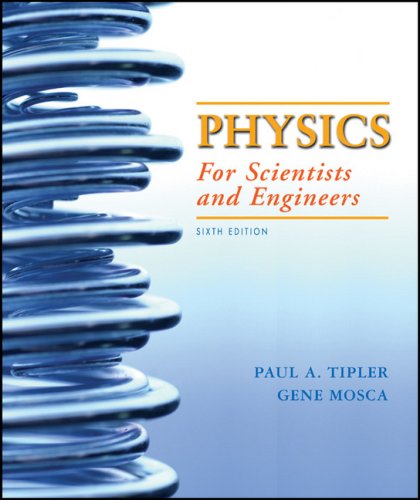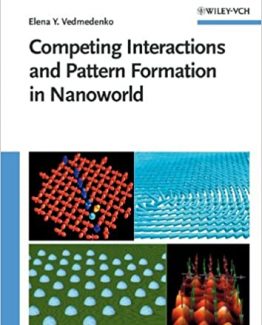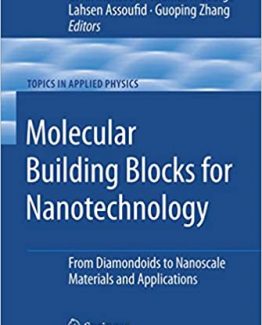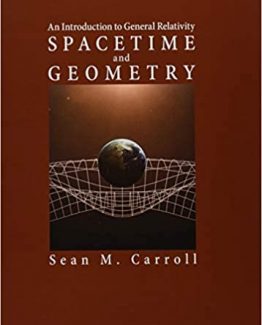Physics for Scientists and Engineers 6th Edition Volume 1 by Paul A. Tipler, ISBN-13: 978-0716789642
[PDF eBook eTextbook]
- Publisher: W. H. Freeman; 6th edition (January 5, 2007)
- Language: English
- ISBN-10: 1429201320
- ISBN-13: 978-0716789642
The Sixth Edition of Physics for Scientists and Engineers offers a completely integrated text and media solution that will help students learn most effectively and will enable professors to customize their classrooms so that they teach most efficiently. The text includes a new strategic problem-solving approach, an integrated Math Tutorial, and new tools to improve conceptual understanding.
Table of Contents:
- Title Page
- Contents in Brief
- Copyright Page
- Preface
- KEY FEATURES
- PROBLEM-SOLVING STRATEGY
- INTEGRATED MATH TUTORIAL
- PEDAGOGY TO ENSURE CONCEPTUAL UNDERSTANDING
- PHYSICS SPOTLIGHTS
- PHYSICS PORTAL
- All Resources in One Place
- Flexibility for Teachers and Students
- Interactive e-Book
- Physics Resources
- Assignment Center
- MEDIA AND PRINT SUPPLEMENTS
- FOR THE STUDENT
- FOR THE INSTRUCTOR
- FLEXIBILITY FOR PHYSICS COURSES
- Custom-Ready Content and Design
- Versions Accomodate Common Course Arrangements
- Acknowledgments
- About the Authors
- Contents
- Chapter 1: MEASUREMENT AND VECTORS
- 1-1: The Nature of Physics
- 1-2: Units
- 1-3: Conversion of Units
- 1-4: Dimensions of Physical Quantities
- 1-5: Significant Figures and Order of Magnitude
- 1-6: Vectors
- 1-7: General Properties of Vectors
- Physics Spotlight: The 2005 Leap Second
- Summary
- Problems
- PART I: MECHANICS
- Chapter 2: MOTION IN ONE DIMENSION
- 2-1: Displacement, Velocity, and Speed
- 2-2: Acceleration
- 2-3: Motion with Constant Acceleration
- 2-4: Integration
- Physics Spotlight: Linear Accelerators
- Summary
- Problems
- Chapter 3: MOTION IN TWO AND THREE DIMENSIONS
- 3-1: Displacement, Velocity, and Acceleration
- 3-2: Special Case 1: Projectile Motion
- 3-3: Special Case 2: Circular Motion
- Physics Spotlight: GPS: Vectors Calculated WhileYou Move
- Summary
- Problems
- Chapter 4: NEWTON’S LAWS
- 4-1: Newton’s First Law: The Law of Inertia
- 4-2: Force and Mass
- 4-3: Newton’s Second Law
- 4-4: The Force Due to Gravity: Weight
- 4-5: Contact Forces: Solids, Springs, and Strings
- 4-6: Problem Solving: Free-Body Diagrams
- 4-7: Newton’s Third Law
- 4-8: Problem Solving: Problems with Two or More Objects
- Physics Spotlight: Roller Coasters and the Need for Speed
- Summary
- Problems
- Chapter 5: ADDITIONAL APPLICATIONS OF NEWTON’S LAWS
- 5-1: Friction
- 5-2: Drag Forces
- 5-3: Motion Along a Curved Path
- *5-4: Numerical Integration: Euler’s Method
- 5-5: The Center of Mass
- Physics Spotlight: Accident Reconstruction— Measurements and Forces
- Summary
- Problems
- Chapter 6: WORK AND KINETIC ENERGY
- 6-1: Work Done by a Constant Force
- 6-2: Work Done by a Variable Force–Straight-Line Motion
- 6-3: The Scalar Product
- 6-4: Work–Kinetic-Energy Theorem—Curved Paths
- *6-5: Center-of-Mass Work
- Physics Spotlight: Coasters and Baggage and Work (Oh My!)
- Summary
- Problems
- Chapter 7: CONSERVATION OF ENERGY
- 7-1: Potential Energy
- 7-2: The Conservation of Mechanical Energy
- 7-3: The Conservation of Energy
- 7-4: Mass and Energy
- 7-5: Quantization of Energy
- Physics Spotlight: Blowing Warmed Air
- Summary
- Problems
- Chapter 8: CONSERVATION OF LINEAR MOMENTUM
- 8-1: Conservation of Linear Momentum
- 8-2: Kinetic Energy of a System
- 8-3: Collisions
- *8-4: Collisions in the Center-of-Mass Reference Frame
- 8-5: Continuously Varying Mass and Rocket Propulsion
- Physics Spotlight: Pulse Detonation Engines: Faster (and Louder)
- Summary
- Problems
- Chapter 9: ROTATION
- 9-1: Rotational Kinematics: Angular Velocity and Angular Acceleration
- 9-2: Rotational Kinetic Energy
- 9-3: Calculating the Moment of Inertia
- 9-4: Newton’s Second Law for Rotation
- 9-5: Applications of Newton’s Second Law for Rotation
- 9-6: Rolling Objects
- Physics Spotlight: Spindizzy—Ultracentrifuges
- Summary
- Problems
- Chapter 10: ANGULAR MOMENTUM
- 10-1: The Vector Nature of Rotation
- 10-2: Torque and Angular Momentum
- 10-3: Conservation of Angular Momentum
- *10-4: Quantization of Angular Momentum
- Physics Spotlight: As the World Turns: Atmospheric Angular Momentum
- Summary
- Problems
- Chapter R: SPECIAL RELATIVITY
- R-1: The Principle of Relativity and the Constancy of the Speed of Light
- R-2: Moving Sticks
- R-3: Moving Clocks
- R-4: Moving Sticks Again
- R-5: Distant Clocks and Simultaneity
- R-6: Relativistic Momentum, Mass, and Energy
- Summary
- Problems
- Chapter 11: GRAVITY
- 11-1: Kepler’s Laws
- 11-2: Newton’s Law of Gravity
- 11-3: Gravitational Potential Energy
- 11-4: The Gravitational Field
- *11-5: Finding the Gravitational Field of a Spherical Shell by Integration
- Physics Spotlight: Gravitational Lenses: A Window on the Universe
- Summary
- Problems
- Chapter 12: STATIC EQUILIBRIUM AND ELASTICITY
- 12-1: Conditions for Equilibrium
- 12.2: The Center of Gravity
- 12-3: Some Examples of Static Equilibrium
- 12-4: Static Equilibrium in an Accelerated Frame
- 12-5: Stability of Rotational Equilibrium
- 12-6: Indeterminate Problem
- 12-7: Stress and Strain
- Physics Spotlight: Carbon Nanotubes: Small and Mighty
- Summary
- Problems
- Chapter 13: FLUIDS
- 13-1: Density
- 13-2: Pressure in a Fluid
- 13-3: Buoyancy and Archimedes’ Principle
- 13-4: Fluids in Motion
- Physics Spotlight: Automotive Aerodynamics: Ride with the Wind
- Summary
- Problems
- PART II: OSCILLATIONS AND WAVES
- Chapter 14: OSCILLATIONS
- 14-1: Simple Harmonic Motion
- 14-2: Energy in Simple Harmonic Motion
- 14-3: Some Oscillating Systems
- 14-4: Damped Oscillations
- 14-5: Driven Oscillations and Resonance
- Physics Spotlight: Moving to the Beat: Millennium Bridge
- Summary
- Problems
- Chapter 15: TRAVELING WAVES
- 15-1: Simple Wave Motion
- 15-2: Periodic Waves
- 15-3: Waves in Three Dimensions
- 15-4: Waves Encountering Barriers
- 15-5: The Doppler Effect
- Physics Spotlight: All Shook Up: Sediment Basins and Earthquake Resonance
- Summary
- Problems
- Chapter 16: SUPERPOSITION AND STANDING WAVES
- 16-1: Superposition of Waves
- 16-2: Standing Waves
- *16-3: Additional Topics
- Physics Spotlight: Echoes of Silence: Acoustical Architecture
- Summary
- Problems
- PART III: THERMODYNAMICS
- Chapter 17: TEMPERATURE AND KINETIC THEORY OF GASES
- 17-1: Thermal Equilibrium and Temperature
- 17-2: Gas Thermometers and the Absolute Temperature Scale
- 17-3: The Ideal-Gas Law
- 17-4: The Kinetic Theory of Gases
- Physics Spotlight: Molecular Thermometers
- Summary
- Problems
- Chapter 18: HEAT AND THE FIRST LAW OF THERMODYNAMICS
- 18-1: Heat Capacity and Specific Heat
- 18-2: Change of Phase and Latent Heat
- 18-3: Joule’s Experiment and the First Law of Thermodynamics
- 18-4: The Internal Energy of an Ideal Gas
- 18-5: Work and the PV Diagram for a Gas
- 18-6: Heat Capacities of Gases
- 18-7: Heat Capacities of Solids
- 18-8: Failure of the Equipartition Theorem
- 18-9: The Quasi-Static Adiabatic Compression of a Gas
- Physics Spotlight: Respirometry: Breathing the Heat
- Summary
- Problems
- Chapter 19: THE SECOND LAW OF THERMODYNAMICS
- 19-1: Heat Engines and the Second Law of Thermodynamics
- 19-2: Refrigerators and the Second Law of Thermodynamics
- 19-3: The Carnot Engine
- *19-4: Heat Pumps
- 19-5: Irreversibility, Disorder, and Entropy
- 19-6: Entropy and the Availability of Energy
- 19-7: Entropy and Probability
- Physics Spotlight: The Perpetual Battle over Perpetual Motion
- Summary
- Problems
- Chapter 20: THERMAL PROPERTIES AND PROCESSES
- 20-1: Thermal Expansion
- 20-2: The van der Waals Equation and Liquid–Vapor Isotherms
- 20-3: Phase Diagrams
- 20-4: The Transfer of Heat
- Physics Spotlight: Urban Heat Islands: Hot Nights in the City
- Summary
- Problems
- PART IV: ELECTRICITY AND MAGNETISM
- Chapter 21:THE ELECTRIC FIELD I: DISCRETE CHARGE DISTRIBUTIONS
- 21-1: Charge
- 21-2: Conductors and Insulators
- 21-3: Coulomb’s Law
- 21-4: The Electric Field
- 21-5: Electric Field Lines
- 21-6: Action of the Electric Field on Charges
- Physics Spotlight: Powder Coating—Industrial Static
- Summary
- Problems
- Chapter 22: THE ELECTRIC FIELD II: CONTINUOUS CHARGE DISTRIBUTIONS
- 22-1: Calculating from Coulomb’s Law
- 22-2: Gauss’s Law
- 22-3: Using Symmetry to Calculate with Gauss’s Law
- 22-4: Discontinuity of En
- 22-5: Charge and Field at Conductor Surfaces
- *22-6: The Equivalence of Gauss’s Law and Coulomb’s Law in Electrostatics
- Physics Spotlight: Charge Distribution—Hot and Cold
- Summary
- Problems
- Chapter 23: ELECTRIC POTENTIAL
- 23-1: Potential Difference
- 23-2: Potential Due to a System of Point Charges
- 23-3: Computing the Electric Field from the Potential
- 23-4: Calculation of V for Continuous Charge Distributions
- 23-5: Equipotential Surfaces
- 23-6: Electrostatic Potential Energy
- Physics Spotlight: Lightning—Fields of Attraction
- Summary
- Problems
- Chapter 24: CAPACITANCE
- 24-1: Capacitance
- 24-2: The Storage of Electrical Energy
- 24-3: Capacitors, Batteries, and Circuits
- 24-4: Dielectrics
- 24-5: Molecular View of a Dielectric
- Physics Spotlight: Changes in Capacitors—Charging Ahead
- Summary
- Problems
- Chapter 25: ELECTRIC CURRENT AND DIRECT-CURRENT CIRCUITS
- 25-1: Current and the Motion of Charges
- 25-2: Resistance and Ohm’s Law
- 25-3: Energy in Electric Circuits
- 25-4: Combinations of Resistors
- 25-5: Kirchhoff’s Rules
- 25-6: RC Circuits
- Physics Spotlight: Vehicle Electrical Systems: Driven to Innovation
- Summary
- Problems
- Chapter 26: THE MAGNETIC FIELD
- 26-1: The Force Exerted by a Magnetic Field
- 26-2: Motion of a Point Charge in a Magnetic Field
- 26-3: Torques on Current Loops and Magnets
- 26-4: The Hall Effect
- Physics Spotlight: Earth and the Sun— Magnetic Changes
- Summary
- Problems
- Chapter 27: SOURCES OF THE MAGNETIC FIELD
- 27-1: The Magnetic Field of Moving Point Charges
- 27-2: The Magnetic Field of Currents: The Biot–Savart Law
- 27-3: Gauss’s Law for Magnetism
- 27-4: Ampère’s Law
- 27-5: Magnetism in Matter
- Physics Spotlight: Solenoids at Work
- Summary
- Problems
- Chapter 28: MAGNETIC INDUCTION
- 28-1: Magnetic Flux
- 28-2: Induced EMF and Faraday’s Law
- 28-3: Lenz’s Law
- 28-4: Motional EMF
- 28-5: Eddy Currents
- 28-6: Inductance
- 28-7: Magnetic Energy
- *28-8: RL Circuits
- *28-9: Magnetic Properties of Superconductors
- Physics Spotlight: The Promise of Superconductors
- Summary
- Problems
- Chapter 29: ALTERNATING-CURRENT CIRCUITS
- 29-1: Alternating Current in a Resistor
- 29-2: Alternating-Current Circuits
- *29-3: The Transformer
- *29-4: LC and RLC Circuits withou ta Generator
- *29-5: Phasors
- *29-6: Driven RLC Circuits
- Physics Spotlight: The Electric Grid: Power to the People
- Summary
- Problems
- Chapter 30: MAXWELL’S EQUATIONS AND ELECTROMAGNETIC WAVES
- 30-1: Maxwell’s Displacement Current
- 30-2: Maxwell’s Equations
- 30-3: The Wave Equation for Electromagnetic Waves
- 30-4: Electromagnetic Radiation
- Physics Spotlight: Wireless: Sharing the Spectrum
- Summary
- Problems
- PART V: LIGHT
- Chapter 31: PROPERTIES OF LIGHT
- 31-1: The Speed of Light
- 31-2: The Propagation of Light
- 31-3: Reflection and Refraction
- 31-4: Polarization
- 31-5: Derivation of the Laws of Reflection and Refraction
- 31-6: Wave–Particle Duality
- 31-7: Light Spectra
- *31-8: Sources of Light
- Physics Spotlight: Optical Tweezers and Vortices: Light at Work
- Summary
- Problems
- Chapter 32: OPTICAL IMAGES
- 32-1: Mirrors
- 32-2: Lenses
- *32-3: Aberrations
- *32-4: Optical Instruments
- Physics Spotlight: Eye Surgery: New Lenses for Old
- Summary
- Problems
- Chapter 33: INTERFERENCE AND DIFFRACTION
- 33-1: Phase Difference and Coherence
- 33-2: Interference in Thin Films
- 33-3: Two-Slit Interference Pattern
- 33-4: Diffraction Pattern of a Single Slit
- *33-5: Using Phasors to Add Harmonic Waves
- 33-6: Fraunhofer and Fresnel Diffraction
- 33-7: Diffraction and Resolution
- *33-8: Diffraction Gratings
- Physics Spotlight: Holograms: Guided Interference
- Summary
- Problems
- PART VI: MODERN PHYSICS: QUANTUM MECHANICS, RELATIVITY, AND THESTRUCTURE OF MATTER
- Chapter 34: WAVE–PARTICLE DUALITY AND QUANTUM PHYSICS
- 34-1: Waves and Particles
- 34-2: Light: From Newton to Maxwell
- 34.3: The Particle Nature of Light: Photons
- 34-4: Energy Quantization in Atoms
- 34-5: Electrons and Matter Waves
- 34-6: The Interpretation of the Wave Function
- 34-7: Wave–Particle Duality
- 34-8: A Particle in a Box
- 34-9: Expectation Values
- 34-10: Energy Quantization in Other Systems
- Summary
- Problems
- Chapter 35: APPLICATIONS OF THE SCHRÖDINGER EQUATION
- 35-1: The Schrödinger Equation
- 35-2: A Particle in a Finite Square Well
- 35-3: The Harmonic Oscillator
- 35-4: Reflection and Transmission of Electron Waves: Barrier Penetration
- 35-5: The Schrödinger Equation in Three Dimensions
- 35-6: The Schrödinger Equation for Two Identical Particles
- Summary
- Problems
- Chapter 36: ATOMS
- 36-1: The Atom
- 36-2: The Bohr Model of the Hydrogen Atom
- 36-3: Quantum Theory of Atoms
- 36-4: Quantum Theory of the Hydrogen Atom
- 36-5: The Spin–Orbit Effect and Fine Structure
- 36-6: The Periodic Table
- 36-7: Optical Spectra and X-Ray Spectra
- Summary
- Problems
- Chapter 37: MOLECULES
- 37-1: Bonding
- *37-2: Polyatomic Molecules
- 37-3: Energy Levels and Spectra of Diatomic Molecules
- Summary
- Problems
- Chapter 38: SOLIDS
- 38-1: The Structure of Solids
- 38-2: A Microscopic Picture of Conduction
- 38-3: Free Electrons in a Solid
- 38-4: Quantum Theory of Electrical Conduction
- 38-5: Band Theory of Solids
- 38-6: Semiconductors
- *38-7: Semiconductor Junctions and Devices
- 38-8: Superconductivity
- 38-9: The Fermi–Dirac Distribution
- Summary
- Problems
- Chapter 39: RELATIVITY
- 39-1: Newtonian Relativity
- 39-2: Einstein’s Postulates
- 39-3: The Lorentz Transformation
- 39-4: Clock Synchronization and Simultaneity
- 39-5: The Velocity Transformation
- 39-6: Relativistic Momentum
- 39-7: Relativistic Energy
- 39-8: General Relativity
- Summary
- Problems
- Chapter 40: NUCLEAR PHYSICS
- 40-1: Properties of Nuclei
- 40-2: Radioactivity
- 40-3: Nuclear Reactions
- 40-4: Fission and Fusion
- Summary
- Problems
- Chapter 41: ELEMENTARY PARTICLES AND THE BEGINNING OF THE UNIVERSE
- 41-1: Hadrons and Leptons
- 41-2: Spin and Antiparticles
- 41-3: The Conservation Laws
- 41-4: Quarks
- 41-5: Field Particles
- 41-6: The Electroweak Theory
- 41-7: The Standard Model
- 41-8: The Evolution of the Universe
- Summary
- Problems
- Appendix A: SI UNITS AND CONVERSION FACTORS
- Appendix B: NUMERICAL DATA
- Appendix C: PERIODIC TABLE OF ELEMENTS
- MATH TUTORIAL
- M-1: SIGNIFICANT DIGITS
- M-2: EQUATIONS
- M-3: DIRECT AND INVERSE PROPORTIONS
- M-4: LINEAR EQUATIONS
- M-5: QUADRATIC EQUATIONS AND FACTORING
- M-6: EXPONENTS AND LOGARITHMS
- M-7: GEOMETRY
- M-8: TRIGONOMETRY
- M-9: THE BINOMIAL EXPANSION
- M-10: COMPLEX NUMBERS
- M-11: DIFFERENTIAL CALCULUS
- M-12: INTEGRAL CALCULUS
- ANSWERS TO ODD-NUMBERED END-OF-CHAPTER PROBLEMS
What makes us different?
• Instant Download
• Always Competitive Pricing
• 100% Privacy
• FREE Sample Available
• 24-7 LIVE Customer Support






Reviews
There are no reviews yet.